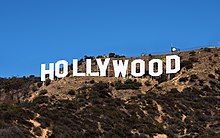| Cinema of the United States (Hollywood)  | |
|---|---|
 The Hollywood Sign in the Hollywood Hills, often regarded as the symbol of the American film industry | |
| No. of screens | 40,393 (2017)[1] |
| • Per capita | 14 per 100,000 (2017)[1] |
| Main distributors | |
| Produced feature films (2016)[2] | |
| Fictional | 646 (98.5%) |
| Animated | 10 (1.5%) |
| Number of admissions (2017)[4] | |
| Total | 1,239,742,550 |
| • Per capita | 3.9 (2010)[3] |
| Gross box office (2017)[4] | |
| Total | $11.1 billion |
| This article is part of a series on the |
| Culture of the United States |
|---|
 |
| Society |
| Arts and literature |
| Other |
| Symbols |
|
United States portal |
The cinema of the United States, consisting mainly of major film studios (also known metonymically as Hollywood), along with some independent films, has had a significant impact on the global film industry since the early 20th century.
Classical Hollywood cinema, which developed from 1910 to 1962, is still typical of most films made in America today. While French filmmakers Auguste and Louis Lumière are generally credited with the birth of modern cinema,[5] American cinema soon came to be a dominant force in the emerging industry. With more than 600 English-language films released annually as of 2017[update], it has produced the fourth-largest number of films of any national cinema, after India, Japan, and China.[6] While the national cinemas of the United Kingdom, Canada, Australia, and New Zealand also produce films in the same language, they are not part of the Hollywood system. Because of this, Hollywood has also been considered a transnational cinema,[7] and has produced multiple language versions of some titles, often in Spanish or French. Contemporary Hollywood often outsources production to the United Kingdom, Canada, Australia, and New Zealand. The major film studios of Hollywood are the primary source of the most commercially successful and most commercially successful movies in the world.[8][9]
Hollywood is considered to be the oldest film industry, where the earliest film studios and production companies emerged. It is the birthplace of various genres of cinema[10]—among them comedy, drama, action, musical, romance, horror, science fiction, [dubious – discuss] and epic—and has set the example for other national film industries.
In 1878, Eadweard Muybridge demonstrated the power of photography to capture motion. In 1894, the world's first commercial motion-picture exhibition was given in New York City, using Thomas Edison's kinetoscope[11] and kinetograph.[12] In the following decades, the production of silent films greatly expanded, studios formed and migrated to California, and the films and stories they told became much longer. The United States produced the world's first sync-sound musical film, The Jazz Singer, in 1927,[13] and was at the forefront of sound-film development in the following decades. Since the early 20th century, the U.S. film industry has primarily been based in and around the thirty-mile zone centered in the Hollywood neighborhood of Los Angeles County, California. Director D. W. Griffith was central to the development of a film grammar. Orson Welles's Citizen Kane (1941) is frequently cited in critics' polls as the greatest film of all time.[14]
- ^ a b "Table 8: Cinema Infrastructure—Capacity". UNESCO Institute for Statistics. Archived from the original on December 24, 2018. Retrieved November 5, 2013.
- ^ "Table 1: Feature Film Production—Genre/Method of Shooting". UNESCO Institute for Statistics. Archived from the original on December 24, 2018. Retrieved May 30, 2019.
- ^ "Cinema—Admissions per capita". Screen Australia. Archived from the original on November 9, 2013. Retrieved November 9, 2013.
- ^ a b "Table 11: Exhibition—Admissions & Gross Box Office (GBO)". UNESCO Institute for Statistics. Archived from the original on December 24, 2018. Retrieved May 30, 2019.
- ^ "The Lumière Brothers, Pioneers of Cinema". History Channel. Retrieved January 15, 2017.
- ^ UIS. "UIS Statistics". data.uis.unesco.org.
- ^ Hudson, Dale. Vampires, Race, and Transnational Hollywoods. Edinburgh University Press, 2017. Website Archived December 22, 2019, at the Wayback Machine
- ^ Kerrigan, Finola (2010). Film Marketing. Oxford: Butterworth-Heinemann. p. 18. ISBN 9780750686839. Retrieved February 4, 2022.
- ^ Davis, Glyn; Dickinson, Kay; Patti, Lisa; Villarejo, Amy (2015). Film Studies: A Global Introduction. Abingdon: Routledge. p. 299. ISBN 9781317623380. Retrieved August 24, 2020.
- ^ Rosenstone, Robert A. (1985). Schatz, Thomas; Isenberg, Michael T.; Roffman, Peter; Purdy, Jim; Cavell, Stanley; Alexander, William (eds.). "Genres, History, and Hollywood. A Review Article". Comparative Studies in Society and History. 27 (2): 367–375. ISSN 0010-4175.
- ^ Billboard. Nielsen Business Media. April 29, 1944. p. 68. ISSN 0006-2510.
- ^ History.com Editors (February 9, 2010). "Thomas Edison patents the Kinetograph". HISTORY. Retrieved November 14, 2024.
{{cite web}}:|last=has generic name (help) - ^ "Why Contemporary Commentators Missed the Point With 'The Jazz Singer'". Time.
- ^ Village Voice: 100 Best Films of the 20th century (2001) Archived March 31, 2014, at the Wayback Machine. Filmsite.org; "Sight and Sound Top Ten Poll 2002". BFI. Archived from the original on May 15, 2012. Retrieved June 19, 2007.